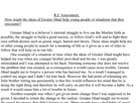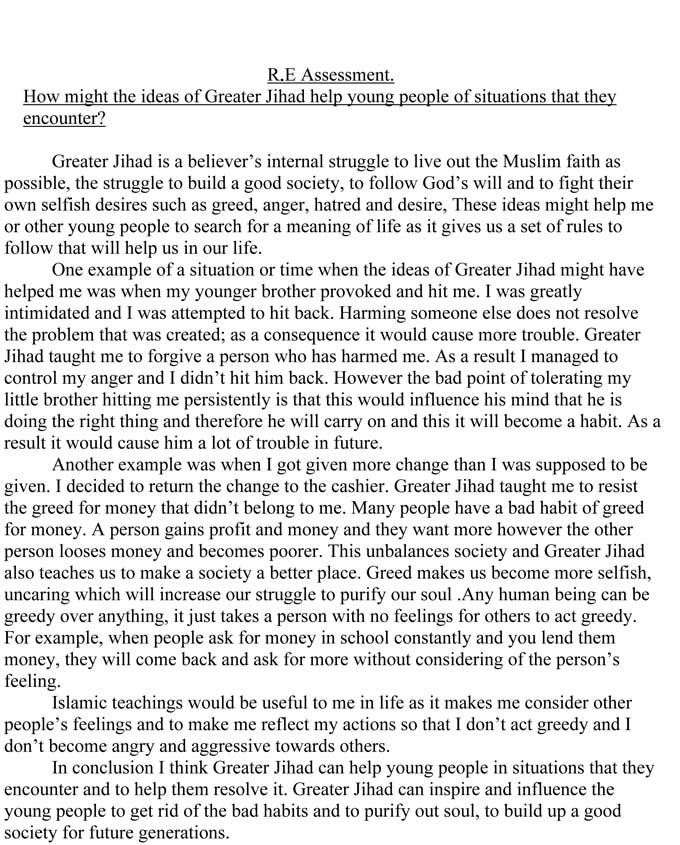Exemplification for foundation subjects
Religious education exemplification standards file level 7
Pupil's profile
Pupil E is an able pupil who is very keen to succeed. He was born in the UK; his parents came to Britain from Vietnam in 1995. His spoken and written English is perfectly fluent. His family are mostly Buddhist, but his late grandfather was Christian (Catholic). Some members of his family have converted from Christianity to Buddhism.
Evidence groups
What would I find difficult about belonging to a religious community?
Context
This lesson followed a series about conversion in religion. Pupils used a range of sources to research monastic life. They then thought of questions to ask a Franciscan nun who visited the class. To bring together everything they had learnt, they wrote an account reflecting on what they thought would be the greatest challenges of belonging to a religious community.
Pupil's work
Next steps
To progress, Pupil E needs to:
challenge others' ideas such as those who would argue that there is no need for monks and nuns in the modern world and justify his own position by synthesising a range of evidence
present a persuasive case about aspects of religion and belief such as the advantages of living a religious life and draw balanced conclusions.
Why do people change their faith and how does it affect them?
Context
Pupils were asked to make a speech about why people change faith and the impact of the decision. Pupil E chose the Christian social reformer Pandita Ramabai (1858-1922) who was born into an intellectual Hindu Brahmin family and converted to Christianity while studying in England and a modern British businessman who also converted from Hinduism to Christianity.
The research carried out by the pupils enabled them to place the stories about conversion into their cultural, historical and personal contexts and to appreciate that conversion experiences may lead to polarised and even critical responses to elements of a religion.
Pupil's work
Assessment Commentary
The teacher reminded pupils that this was a controversial topic and that people have deeply personal reasons for converting from one faith to another. Pupil E has researched and analysed the differences in the impact of conversion on two individuals.
Thinking about religion and belief:
Pupil E analysed some of the reasons for conversion and the consequences of conversion for the individuals involved and their communities. He proposes that there are internal and external influences over conversion.
He has considered some of the reasons why Pandita Ramabai converted from Hinduism to Christianity and suggested what may be the most powerful influence. He has concluded that reasons for conversion are diverse, may change over time and that culture may affect the nature of the conversion. He has explained some of the influence of history and culture in his discussion of Henry VIII and the Protestant Reformation.
Enquiring, investigating and interpreting:
In completing this task, Pupil E used a wide range of relevant evidence, examples and sources. He has provided evidence to support his arguments, for example he refers to Henry VIII, two people who have experienced conversion and Jesus' teaching in Luke's Gospel of the Bible.
Reflecting, evaluating and communicating:
Pupil E has begun to evaluate the viewpoints of different people and illustrates these views with examples from different historical periods - Henry VIII in the 16th century, Pandita Ramabai in the 19th century and a British businessman in modern times. These individuals also provide a useful social and cultural contrast.
In the final paragraph he shows he can consider an alternative view from the one presented by the converts when he says, 'The reasons for conversation might change over time, such as, an untouchable felt that he was treated the same and this was his only reason for converting, however, once he has converted and that he has succeeded a place in society, he might feel that his original religion has stronger roots than [his] new religion.' This last motivation is non-religious, illustrating that Pupil E is aware of the complexity of decisions about conversion.
Next steps
To progress, Pupil E needs to:
analyse different interpretations of religious and moral sources so that he can articulate the arguments a Hindu might make in response to Pandita Ramabai
interpret religions and beliefs in their historical, social and cultural contexts so he might for example understand the range of influences on Pandita Ramabai or the modern business man.
How might the ideas of greater jihad help young people?
Context
This piece of work was part of a unit where pupils used Islamic teachings and sources to explore the effect of Islamic belief on Muslims' lives. Pupils learnt about the greater jihad (the personal individual struggle against evil in the way of Allah) and considered whether Islamic teachings could be usefully applied in their own lives. Applying the concept to situations they might encounter helped pupils learn about and from religion and belief in a familiar context, which deepened their understanding.
Pupil's work
Assessment commentary
Pupil E has reflected on the implications of applying greater jihad to different situations in his life. His reflections show he understands the concept.
Thinking about religion and belief:
In answering the question, Pupil E describes when he was given extra change by a cashier and reflects on his personal struggle and the wider implications of deciding to give the money back: 'Greater Jihad taught me to resist the greed for money that didn't belong to me. Many people have a bad habit of greed for money...This unbalances society and Greater Jihad also teaches us to make society a better place.' He has used the abstract concept of the greater jihad to analyse an issue of religion and belief, in this case, moral decision making.
He has analysed some of the potential consequences of a young person applying the idea of greater jihad to their life: '…it makes me consider other people's feelings and to make me reflect [on] my actions…I think Greater Jihad can help young people in situations that they encounter and help them resolve it. Grater Jihad can inspire and influence the young people to get rid of the bad habits and to purify our soul...'. He has appreciated the key element of the greater jihad in acknowledging the idea that all people have bad habits and tendencies and that self-awareness is the beginning of making a change.
Next steps
To progress, Pupil E needs to:
bring together a wide range of viewpoints about the application of religious teachings to moral dilemmas
consider how jihad or another abstract concept related to his studies might be applied in a range of historical, social and cultural contexts.
How do Islamic teachings affect the life of a young Muslim living in the West?
Context
This piece of work was part of a unit where pupils used Islamic teachings and sources to explore the effect of Islamic belief on Muslims' lives. Pupils were given six letters to an agony aunt, each describing a problem faced by a young British Muslim, and asked to reflect on the dilemma from a Muslim perspective. They were encouraged to refer to relevant Islamic teachings in their reflections.
Pupil's work
_medium_tcm8-17462.jpg)
How do Islamic teachings affect young lives? (cont.)
Assessment commentary
Pupil E and his classmates enjoyed considering familiar dilemmas from a different viewpoint. In his responses, Pupil E has considered important questions about personal values, the meaning of human life and the truths that may be found in religious texts.
Thinking about religion and belief:
In responding to dilemma 4, Pupil E has used abstract concepts to analyse the application of Islamic values in dealing with the problems created by people using text messages to spread gossip. He has recognised the powerful truth presented by the Islamic text when he says 'In Dilemma 4, the Muslim boy shouldn't of [sic] sent the text, as a punishment he receives the powerful emotion, guilt. In the teachings it says, "The worst people are those who gossip and backbite to create rifts among friends," such as the Muslim boy had done.'
Enquiring, investigating and interpreting:
Throughout Pupil E has used a wide range of relevant evidence, such as examples of different dilemmas and Qur'anic sources, to explore the impact of the ideas. For example he writes 'Muslims recite, "God you made me so beautiful, so make my character beautiful too" this should that your character is unique and you should not attempt to tamper or change it, or your look. This means that you should not be jealous of other people as jealously is a cruel, selfish characteristic.'
Next steps
To progress, Pupil E needs to:
explore a wider variety of forms of religious, spiritual and moral expression, for example study how religious truths and questions of meaning are represented in many different forms of religious and spiritual art and produce his own interpretation of these ideas
consider the interrelationship between religions and beliefs and other disciplines such as psychology and medical ethics when responding to moral dilemmas such as these.
How can Muslims represent stories in art?
Context
This piece of work was part of a unit where pupils used Islamic teachings and sources to explore the effect of Islamic belief on Muslims' lives. Pupils learnt how Muslims use forms of art to express their beliefs. They visited a local mosque to learn about the architecture and decorative features. They then researched conventions in Islamic art and discussed the range of views about art found around the world and in history.
Pupils selected a story from the life of Muhammad and used the conventions of Islamic art to depict the story in artwork. They explained what their art showed and justified their decisions about how they represented the religious ideas of the story.
Pupil's work
Assessment commentary
Pupil E has interpreted the use of pattern and symbol in religious art order to depict a story from Islam.
Thinking about religion and belief:
Pupil E has drawn on accounts of the history of Islam to explain how the experiences of Muhammad growing up in a culture dominated by idolatry in Makkah influenced his attitudes to idol worship. 'Muhammad (the seal and most important of the prophets) hated idols and was born in a place where idols and idolatry was commonly practiced [sic]. Muhammad believed that images of life contradicted Muslim beliefs' and 'Another reason for Muhammad's disgust of idols was that the annual pilgrimage during Muhammad's early life in Makkah caused the rich to get richer and the poor to get poorer. People would come from miles around to visit the Ka'aba and worship the idols placed in and around it..'
Enquiring, investigating and interpreting:
Pupil E has explored how stories from religious traditions may be represented in art. He has used a wide range of relevant sources such as quotations from both the Qur'an and Hadith to support his rationale for selecting images. For example he says, 'My piece of artwork shows the main features of the religious story I picked, as it highlights the descending light, showing the message from Allah was sent down from heaven above: "He it is Who has send down to thee the Book."'
Pupil E has also used evidence to explore the reasons why most Muslims do not represent the human form and sometimes any living thing. He cites Christianity, Judaism and Islam as examples of religions where a star is used as a symbol and uses these examples to justify his choice of a star to represent God: 'The star can therefore be used to symbolise honour or high important status consequently, I think it can be used to represent God or an immortal being.'
Next steps
To progress, Pupil E needs to:
- explore and interpret a wider range of forms of religious, spiritual and moral expression, either within or between religions and beliefs, for example within the context of Islam be could study the ancient Sufi poetry of Rumi or the different art forms created by the Ahmed Moustafa.
How can meditative activities help Buddhists and us live harmoniously in a community?
Context
This piece of work formed part of a unit on Buddhism. Pupils investigated attitudes to meditative practice mainly within Buddhism but also in other religions and secular contexts such as its use in mental health care. A Buddhist visitor led the class in a contemplative activity to give pupils an experience of an element of meditation. Pupils then debated in small and large groups whether or not this practice might have a role to play in helping society become more harmonious.
Pupil's work
Assessment commentary
Pupil E has analysed a key question about the extent to which meditative practices might be beneficial for society in helping people to live together harmoniously.
Thinking about religion and belief:
He has used abstract concepts such as compassion, peace and happiness to analyse the impact of meditation on his own life and its potential impact on society as a whole: '…meditation helps you become more compassionate and increases our happiness. Also one realises how someone feels during meditation, as a result it determines our actions. If one realises how it feels to be bullied then one would act with greater compassion to others. As a result by understanding others we can realise that in order to live in a harmonious community, compassion must be given and shown to everyone, even the people that we dislike or find irritating.'
Enquiring, investigating and interpreting:
Pupil E used the method of participant observation to study a Buddhist practice and considered the effect of meditative practices on himself: '…it helps me become clear minded therefore I am fully concentrated on what I am doing such as a test, without anxiety which enables me to do well.' He has also reflected on the way this might affect others: 'Also it makes me feel very happy, affectionate and compassionate; as a result this determines my behaviour and actions to others.' Finally he has speculated on the meaning of the practice in terms of his own spiritual development: 'Also it helps me advance on, on my journey to enlightenment by understanding life and its purpose…'.
Next steps
To progress, Pupil E needs to:
use his understanding of religions and beliefs to interpret a wider range of religious expression such as dance, music, prayer and silence.
Overall assessment judgement
Religious education exemplification standards level 7
Overall, Pupil E is working at level 7.
Thinking about religion and belief:
Pupil E approaches religious and non-religious ideas systematically and analytically. He has used abstract concepts to write coherently about religions and beliefs, their influence on individuals and communities, how they are influenced by history and culture and how they relate to issues in the modern world.
Enquiring, investigating and interpreting:
Pupil E has been encouraged to continue his learning and enquiry independently outside the classroom and often raises original ideas in class discussion. He has recognised the value of his own and other people's personal experiences as an important source of evidence when exploring religious ideas and practices. He has used questions, evidence and examples in his writing in order to write critically about aspects of religion and belief.
Reflecting, evaluating and communicating:
Pupil E enjoys classroom debate and is able to use evidence and his own experience to good effect to support his views. He has analysed a view that contrasts with his own and responded with an original idea. He speaks and writes openly about his personal search for meaning and is often insightful about the views of others. He has evaluated religious and non-religious viewpoints and used his personal experience of different cultures to compare their significance to the particular issue under discussion.
The extracts of pupil work below are a reminder of some of the evidence used to make these judgements.





_thumb_tcm8-16994.jpg)
_thumb_tcm8-16995.jpg)
_medium_tcm8-17461.jpg)


Assessment commentary
Pupil E has suggested various reasons for joining a religious community. He has compared a religious life with that of an ordinary person and evaluated whether or not the challenges and rewards would outweigh the sacrifices.
Enquiring, investigating and interpreting:
Pupil E reflected on what he considered would be the greatest challenges of a monastic life and then composed critical questions for the Franciscan Sister and the Buddhist monk. As well as his discussions with the nun and monk, he used a range of relevant written sources, such as a textbook about Mother Teresa and a transcript of an interview with Sister Rachel. He arranged his interview with the Buddhist monk independently, without help from his teacher.
Reflecting, evaluating and communicating:
Pupil E has articulated insightful personal, critical responses to the key question of what he might find difficult about the life of a monk, concluding with the statement: 'The hard challenges such as wealth, relationships would be worth sacrificing to achieve obedience over yourself and prayer. As once achieved you will acknowledge the true meaning of life, your purpose on earth and redeem yourself of all the sins your have caused'.
He has shown he can analyse contrasting viewpoints on life, comparing how a Buddhist monk and an ordinary person would spend free time. Statements such as 'Sister Chris mentioned that sacrificing is the reward however, there are drawbacks; times when you regret the things you've sacrificed' show that he can compose a critical argument.
He also analyses contrasting viewpoints, including his own: 'I can sacrifice wealth and relationships however, obedience is hard to obtain. The obedience of prayer would be difficult if ones mind is apt to wander; stressing over…whilst the objective is to contemplate on God'.